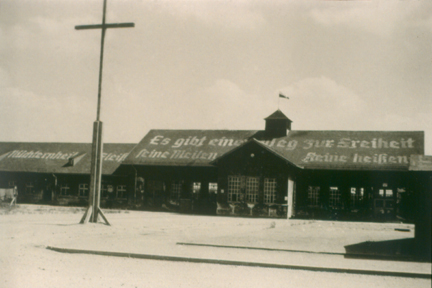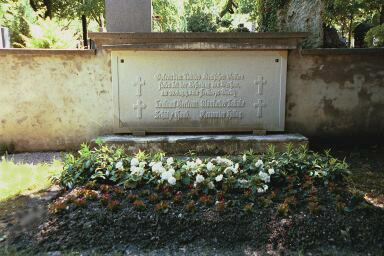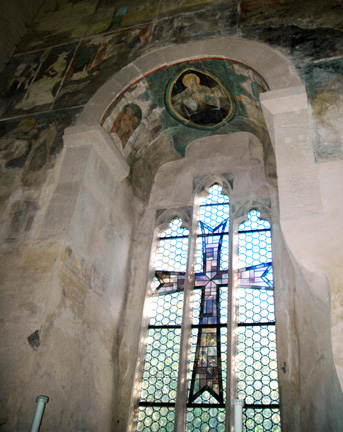A new book, entitled Principalities and Powers: Spiritual Combat 1942 – 1943, mentions a Dutch Carmelite priest named Father Titus Brandsma who has the title of “Blessed” because he has been canonized as a saint in the Catholic Church.
![Father Titus Brandsma was a prisoner at Dachau]()
Father Titus Brandsma was a prisoner at Dachau
This quote is from the news article about the book and it’s author Father George William Rutler:
Fr Rutler, a parish priest in Manhattan, New York and a well-known essayist, has taken his title from the famous quotation in St Paul’s Letter to the Ephesians. This is in part because of he wishes to show the larger forces at work during WWII and also because an old friend and fellow priest had bequeathed to him a pile of newspapers, journals and radio transcripts for this particular year. Growing up after the war, Rutler sees his book as “a feeble act of thanks from my generation” for the previous one that had endured so many sacrifices on behalf of future ones. -
According to an article which you can read in full
here, the author of the book, George William Rutler, “is fascinated by the way large historical events interweave with humbler but no less significant spiritual occurrences, relating that on the day of the British defeat in the first battle of El Alamein,
Fr Titus Brandsma, a Dutch Carmelite, died in Dachau after giving his Rosary to the SS functionary who gave him a lethal injection.This quote is from the article about the new book:
WWII “can rightly be understood and probably only fully appreciated as a holy war fought for multiple and mixed motives, but in its deepest meaning as a campaign against evil by defenders, consciously or obliviously, of the good.” Doubtless, secular historians such as Andrew Roberts or Sir Max Hastings, who has researched the “multiple and mixed motives” of the war in detail in his own books, would not demur from this conclusion. Certainly Churchill, not a conventional Christian believer but with a deep sense of what a Christian civilization signified, would have agreed with it.
It seems that Father Titus Brandsma was a martyr in the “holy war” now known as World War II. But why was he singled out to be killed?
Dachau was the concentration camp where 2,720 clergymen were sent, including 2,579 Catholic priests. The priests at Dachau were separated from the other prisoners and housed together in several barrack buildings in the rear of the camp. There were 1,780 Polish priests and 447 German priests at Dachau. Of the 1,034 priests who died in the camp, 868 were Polish and 94 were German. Most of them died as a result of the typhus epidemic in the camp.
Other clergymen at Dachau included 109 Protestant ministers, 22 Greek Orthodox, 2 Muslims and 8 men who were classified as “Old Catholic and Mariaists.”
One of the most famous Catholic priests, who was imprisoned at Dachau, was Blessed Father Titus Brandsma, a 61 year old Dutch priest, who was at Dachau for only five months before he was killed by an injection in the camp hospital on July 26, 1942; he was killed by injection because he was suffering from terminal kidney failure.
According to the accounts of his fellow priests, Father Brandsma was beaten and kicked daily even though he was already sick when he arrived in the camp on June 19, 1942. At first, Father Brandsma refused to enter the camp infirmary, and when he did finally consent, Father Brandsma was allegedly forced to participate in medical experiments.
Father Titus Brandsma had been arrested by the Nazis on January 19, 1942 in the Netherlands, which had been under German occupation since May 1940.
On January 15, 1942 the Nazis had sent articles to all the Catholic newspapers with orders that they be published the following day. All of the editors refused because on December 31, 1941, Father Brandsma had drawn up a letter to the 30 Catholic newspapers, urging all the Catholic editors in the Netherlands to violate the laws of the German occupation by not publishing any Nazi propaganda.
Father Brandsma had previously written a Pastoral Letter, read in all Catholic parishes in July 1941, in which the Dutch Roman Catholic bishops officially condemned the anti-Semitic laws of the Nazis and their treatment of the Jews. Dutch Catholics were informed by this letter that they would be denied the Sacraments of the Catholic church if they supported the Nazi party.
Father Brandsma had been very vocal in his opposition to the Nazi ideology ever since Hitler came to power in 1933. He was a prolific writer who had articles published in 80 different publications.
On January 21, 1942, Father Brandsma was put on trial and quickly convicted of treason because he refused to cooperate with the German occupation. Blessed Titus Brandsma died a martyr for the right of freedom of the press in an occupied country.
Pope John Paul II beatified Titus Brandsma in 1985, giving him the title of Blessed Titus Brandsma.
Father Titus Brandsma was a professor of Philosophy and Mysticism at the University of Nijmegan in the Netherlands. He belonged to The Order of the Brothers of Our Lady of Mount Carmel, a religious order that is believed to have been founded in the 12th century on Mount Carmel. The Carmelite priests were dedicated to the worship of Mary, the mother of God.
![Entrance into the Carmelite Chapel at Dachau]()
Entrance into the Carmelite Chapel at Dachau
At the Dachau Memorial Site, there is a Carmelite convent which was built in 1963 just outside the former camp. The entrance to the convent is through one of the former guard towers, which is shown in the photo above. The convent was built on the site of the gravel pit where prisoners had been assigned to work as punishment for breaking the rules in the camp.
Catholic priests were not sent to Dachau just because they were priests. Catholics and Protestants alike were arrested as “enemies of the state” but only if they preached against the Nazi government.
An important policy of the Nazi party in Germany was called Gleichschaltung, a term that was coined in 1933 to mean that all German culture, religious practice, politics, and daily life should conform with Nazi ideology. This policy meant total control of thought, belief, and practice and it was used to systematically eradicate all anti-Nazi elements after Hitler came to power.
There were around 20 million Catholics and 20,000 priests in Nazi Germany. The vast majority of the German clergymen and the German people, including the 40 million Protestants, went along with Hitler’s ideology and were not persecuted by the Nazis.
The first clergymen to arrive at Dachau were Polish priests who were sent there in 1939. The Polish priests had been arrested for helping the Polish Resistance after Poland had been conquered in only 28 days.
The largest number of Catholic priests at Dachau were the 1780 priests from Poland. The largest number of deaths of priests at Dachau was 868 from Poland. There were 830 Polish priests at Dachau when the camp was liberated, but 78 priests had already been released.
Bishop Franciszek Korczynski from Wloclawek, Poland published a book in 1957, entitled “Jasne promienie w Dachau” (Bright Beams in Dachau) in which he claimed that the extermination of the Polish clergy was planned by the Nazis as part of the liquidation of the Polish intelligentsia. He wrote that the priests at Dachau were starved and tortured and that the Nazis used the priests for medical experiments.
I got much of the information for my blog post today from a book entitled “What was it like in the Concentration Camp at Dachau?” written by Dr. Johannes Neuhäusler. I purchased this book at the Dachau Memorial Site on my first visit in 1997.
In his book, Dr. Neuhäusler wrote that, out of the 2720 clergymen imprisoned at Dachau, 314 were released, 1034 died in the camp, 132 were transferred to another camp, and 1240 were still in the camp when it was liberated on April 29, 1945.
The highest number of priests that were released from Dachau was the 208 German priests. Out of the 447 German priests at Dachau, 100 were transferred to other camps and 94 died in the camp; there were only 45 German priests at Dachau when the camp was liberated.
The first German priest to enter Dachau in 1940 was Father Franz Seitz, according to Dr. Neuhäusler’s book. The first priests were put into Block 26, but it soon became over crowded because “practically all the priests interned in the camp at Sachsenhausen-Oranienburg were transferred to Dachau, especially many hundreds of Polish clergymen,” according to Dr. Neuhäusler.
Dr. Neuhäusler wrote that an emergency chapel was set up in Block 26 and on January 20, 1941 the first Mass was celebrated. “Some 200 priests stood enraptured before the altar while one of their comrades, wearing white vestments offered up the Holy Sacrifice.”
In 1940, the German bishops and the Pope had persuaded Reichsführer-SS Heinrich Himmler to concentrate all the priests imprisoned in the various concentration camps into one camp, and to house them all together in separate blocks with a chapel where they could say Mass.
In early December 1940, the priests already in Dachau were put into Barracks Block 26 near the end of the camp street. Within two weeks, they were joined by around 800 to 900 priests from Buchenwald, Mauthausen, Sachsenhausen, Auschwitz and other camps, who were put into Blocks 28 and 30. Block 30 was later converted into an infirmary barrack.
One of the priests at Dachau, Father William J. O’Malley, wrote the following regarding the priests who were arrested and sent to Dachau because they were actively helping the underground Resistance against the German occupation of Europe:
“The 156 French, 63 Dutch, and 46 Belgians were primarily interned for their work in the Underground. If that were a crime, such men as Michel Riquet, S.J., surely had little defense; he was in contact with most of the leaders of the French Resistance and was their chaplain, writing forthright editorials for the underground press, sequestering Jews, POW’s, downed Allied airmen, feeding and clothing them, providing them with counterfeit papers and spiriting them into Spain and North Africa.”
Was Father Brandsma forced to be a subject of medical experiments at Dachau? He was already 61 years old and he was already sick when he was admitted into the Dachau camp. It is highly unlikely that he was used as a subject of medical experiments.
![Dr. Schilling was put on trial at Dachau because he conducted medical experiments on the prisoners]()
Dr. Schilling was put on trial at Dachau because he had conducted medical experiments
Dr. Klaus Schilling, shown in the photo above as he testified on the witness stand in the post-war trial of the Dachau staff, was put on trial and convicted by the American Military Tribunal because he had conducted medical experiments on inmates at Dachau.
Dr. Schilling was one of the world’s foremost experts on tropical diseases when he was ordered by Reichsführer-SS Heinrich Himmler, the head of all the Nazi concentration camps, to come out of retirement to work on a cure for malaria after German soldiers began dying of the disease in North Africa. Before his retirement, Dr. Schilling had worked at the prestigious Robert Koch Institute in Berlin. He began specializing in tropical diseases after he himself contracted malaria.
After the war, Dr. Schilling was arrested by the American Army and charged with participating in a “common plan” to violate the Laws and Usages of War under the Geneva Convention of 1929 because he had conducted experiments on Dachau prisoners, using various drugs in an effort to find a cure for malaria. Most of his subjects were young Polish priests whom Dr. Schilling infected by means of mosquitoes from the marshes of Italy and the Crimea, according to author Peter Padfield in his book entitled “Himmler.” The priests were chosen for the experiments because they were not required to work, as were the ordinary prisoners at Dachau.
One of the prosecution witnesses at the trial of the German Major War Criminals at the Nuremberg International Military Tribunal was Dr. Franz Blaha, a Czech medical doctor who was a Communist political prisoner at Dachau. An affidavit signed by Dr. Blaha was entered into the main Nuremberg trial. It was marked Document Number 3249-PS, Exhibit USA-663.
His comments in this affidavit about Dr. Schilling are quoted below from the transcript of the Nuremberg trial for January 11, 1946
“3. During my time at Dachau I was familiar with many kinds of medical experiments carried on there on human victims. These persons were never volunteers but were forced to submit to such acts. Malaria experiments on about 1,200 people were conducted by Dr. Klaus Schilling between 1941 and 1945. Schilling was personally ordered by Himmler to conduct these experiments. The victims were either bitten by mosquitoes or given injections of malaria sporozoites taken from mosquitoes. Different kinds of treatment were applied including quinine, pyrifer, neosalvarsan, antipyrin, pyramidon, and a drug called 2516 Behring. I performed autopsies on the bodies of people who died from these malaria experiments. Thirty to 40 died from the malaria itself. Three hundred to four hundred died later from diseases which were fatal because of the physical condition resulting from the malaria attacks. In addition there were deaths resulting from poisoning due to overdoses of neosalvarsan and pyramidon. Dr. Schilling was present at my autopsies on the bodies of his patients.”
The 74-year-old Dr. Schilling was convicted by an American Military Tribunal at Dachau and was hanged. In his final statement to the court, Dr. Schilling pleaded to have the results of his experiments returned to him so they could be published, but his work was confiscated and used by the US military. During his trial, Dr. Schilling tried to justify his crime by saying that his experiments were for the good of mankind.
Filed under:
Dachau,
Germany,
World War II Tagged:
Carmelite priests,
George William Rutler,
Priests at Dachau,
Titus Brandsma ![]()
![]()
















































































